Estimation of Nearshore Wind Conditions Using Onshore Observation Data with Computational Fluid Dynamic and Mesoscale Models
Abstract
:1. Introduction
2. Observation Data and Methods
2.1. Observation
2.2. Numerical Simulations
2.2.1. CFD Model
2.2.2. Mesoscale Model
3. Results and Discussion
3.1. CFD Model Sensitivity to Observation Height of Input Data
3.2. Vertical Wind Speed Profile at CWO
3.3. Features of Wind Direction
3.4. Wind Condition Formed by Thermodynamic Effects
3.5. Wind Speed Map Estimated Using Numerical Models
4. Conclusions
- When estimating offshore wind speed based on a CFD model and onshore LiDAR measurements, the estimation accuracy greatly depends on the measurement height of the LiDAR measurements used as input data for the CFD model. In this case, the bias was positive and large when upper height measurements were used as the input. The bias reached +17.9% when the 264 m height data were used. Thus, proper selection of the input height is vital for successful estimation using the CFD model. In general, a height close to the offshore target, such as the hub height of a wind turbine, should be selected as the input data, given that the accuracy of the wind speed shear replicated in a CFD numerical model may be uncertain, as it cannot replicate thermal effects.
- In the study area, LiDAR measurements at the CWO demonstrate that the vertical shear and veer of the wind were not dynamically influenced by thermodynamic phenomena, such as land and sea breezes. The CFD model cannot reproduce wind veer well as it does not consider thermodynamic effects. This is one of the primary causes of the inaccurate estimation by the CFD model for the offshore site.
- Compared to the CFD model, the mesoscale model accurately replicated the wind conditions formed by the thermodynamic effect, exhibiting a bias of +2.0% in the SOO estimation, without any corrections using observation data. Regarding the wind speed profile at the CWO, large estimation errors were, however, found at lower heights compared to upper heights. Additionally, the gradient of the wind speed from land to sea estimated by the mesoscale model demonstrated a smaller gradient, as has been previously reported by studies conducted in Japan [24,45]. These results indicate that the mesoscale model is likely to overestimate wind speed in nearshore waters, especially in areas extremely close (e.g., 1 km) to the coastline.
Author Contributions
Funding
Data Availability Statement
Acknowledgments
Conflicts of Interest
References
- Obane, H.; Nagai, Y.; Asano, K. Assessing the potential areas for developing offshore wind energy in Japanese territorial waters considering national zoning and possible social conflicts. Mar. Policy 2021, 129, 104514. [Google Scholar] [CrossRef]
- JWPA, Offshore Wind Power Development in Japan. 2017. Available online: https://jwpa.jp/cms/wp-content/uploads/20170228_OffshoreWindPower_inJapan_r1.pdf (accessed on 17 October 2022).
- Dodd, J. Do we still need met masts? Wind. Mon. 2018, 34. Available online: https://www.windpowermonthly.com/article/1458018/need-met-masts (accessed on 17 October 2022).
- Peña, A.; Hasager, C.; Gryning, S.; Courtney, M.; Antoniou, I.; Mikkelsen, T. Offshore wind profiling using light detection and ranging measurements. Wind Energy 2009, 12, 105–124. [Google Scholar] [CrossRef]
- Shimada, S.; Takeyama, Y.; Kogaki, T.; Ohsawa, T.; Nakamura, S. Investigation of the fetch effect using onshore and offshore vertical LiDAR devices. Remote Sens. 2018, 10, 1408. [Google Scholar] [CrossRef] [Green Version]
- Shimada, S.; Kogaki, T.; Takeyama, Y.; Ohsawa, T.; Nakamura, S.; Kawaguchi, K. Accuracy of offshore wind measurements using a scanning LiDAR. Grand Renew. Energy 2018, 35, 135–138. [Google Scholar]
- MEASNET. MEASNET Evaluation of Site-specific Wind Conditions—Version 3; MEASNET: Madrid, Spain, 2022. [Google Scholar]
- IEC. IEC61400-12-1 Wind Turbines—Part 12-1: Power Performance Measurements of Electricity Producing Wind Turbines, 3rd ed.; IEC: London, UK, 2022. [Google Scholar]
- Ishihara, T.; Hibi, K. Numerical study of turbulent wake flow behind a three-dimensional steep hill. Wind. Struct. 2007, 5, 317–328. [Google Scholar] [CrossRef]
- Ishihara, T.; Yamaguchi, A.; Fujino, A. Nonlinear model for predictions of turbulent flow over steep terrain. In Proceedings of the World Wind Energy Conference and Exhibition, Berlin, Germany, 2–6 July 2002; pp. 1–4. [Google Scholar]
- Uchida, T.; Ohya, Y. Micro-siting technique for wind turbine generators by using large-eddy simulation. J. Wind Eng. Ind. Aerodyn. 2008, 96, 2121–2138. [Google Scholar] [CrossRef]
- Sempreviva, A.M.; Barthelmie, R.J.; Pryor, S.C. Review of methodologies for offshore wind resource assessment in European seas. Surv. Geophys. 2008, 29, 471–497. [Google Scholar] [CrossRef]
- Peña, A.; Hahmann, A.; Hasager, C.; Bingöl, F.; Karagali, I.; Badger, J.; Badger, M.; Clausen, N. South Baltic Wind Atlas. 2011. Available online: http://orbit.dtu.dk/files/5578113/ris-r-1775.pdf (accessed on 17 October 2022).
- Hahmann, A.N.; Lennard, C.; Badger, J.; Vincent, C.L.; Kelly, M.C.; Volker, P.J.; Argent, B.; Refslund, J. Mesoscale Modeling for the Wind Atlas of South Africa (WASA) Project; E No. 0050; DTU Wind Energy: Roskilde, Denmark, 2014; Volume 80. [Google Scholar]
- Chang, R.; Zhu, R.; Badger, M.; Hasager, C.B.; Xing, X.; Jiang, Y. Offshore wind resources assessment from multiple satellite data and WRF modeling over South China Sea. Remote Sens. 2015, 7, 467–487. [Google Scholar] [CrossRef] [Green Version]
- Mattar, C.; Borvarán, D. Offshore wind power simulation by using WRF in the central coast of Chile. Ren. Energy 2016, 94, 22–31. [Google Scholar] [CrossRef]
- Washio, T.; Sakamoto, N.; Nakashima, S.; Aoki, I.; Kawaguchi, K.; Nagai, T.; Nakai, K. Construction of ocean observation tower system off the Kita-Kyushu city for offshore wind farm design. J. Jpn Soc. Civ. Eng. 2013, 69, I.1–1.6. (In Japanese) [Google Scholar]
- Skamarock, W.C.; Klemp, J.B.; Dudhia, J.; Gill, D.O.; Barker, D.M.; Wang, W.; Powers, J.G. A Description of the Advanced Research WRF Version 3; Tech. Note TN-475+STR; National Center for Atmospheric Research: Boulder, CO, USA, 2008; pp. 1–96. [Google Scholar]
- NEDO. The NEDO Offshore Wind Information System. Available online: https://appwdc1.infoc.nedo.go.jp/Nedo_Webgis/top.html (accessed on 17 October 2022).
- Ohsawa, T.; Kozai, K.; Nakamura, S.; Kawaguchi, K.; Shimada, S.; Takeyama, Y.; Kogaki, T. Accuracy of WRF simulation in the NEDO offshore wind resource map. Proceeding Jpn. Wind. Energy Symp. 2016, 38, 17–20. (In Japanese) [Google Scholar]
- Ohsawa, T.; Uede, H.; Misaki, T.; Kato, M. Accuracy of WRF Simulations Used for Japanese Offshore Wind Resource Maps. International Conference on Energy and Meteorology. 2017. Available online: http://www.wemcouncil.org/ICEMs/ICEM2017_PRES/ICEM_20170629_1120_Sala_2_Ohsawa.pptx (accessed on 17 October 2022).
- Shimada, S.; Ohsawa, T.; Chikaoka, S.; Kozai, K. Accuracy of the wind speed profile in the lower PBL as simulated by the WRF model. SOLA 2011, 7, 109–112. [Google Scholar] [CrossRef] [Green Version]
- Misaki, T.; Ohsawa, T. Evaluation of LFM-GPV and MSM-GPV as input data for wind simulation. J. JWEA 2018, 42, 72–79. [Google Scholar]
- Kato, M.; Ohsawa, T.; Uede, H.; Shimada, S. Verification of spatial characteristics of WRF-simulated wind speed in Japanese coastal waters. Proc. Jpn. Wind. Energy Symp. 2017, 39, 253–256. (In Japanese) [Google Scholar]
- Mortensen, N.; Landberg, L.; Troen, I.; Petersen, E. Wind Atlas Analysis and Application Program (WAsP); Risoe-I-666(EN); Getting started; Risø National Laboratory: Roskilde, Denmark, 1993; Volume 1. [Google Scholar]
- Carvalho, D.; Rocha, A.; SilvaSantos, C.; Pereira, R. Wind resource modelling in complex terrain using different mesoscale–microscale coupling techniques. Appl. Energy 2013, 108, 493–504. [Google Scholar] [CrossRef]
- Beaucage, P.; Brower, M.C.; Tensen, J. Evaluation of four numerical wind flow models for wind resource mapping. Wind Energy 2014, 17, 197–208. [Google Scholar] [CrossRef]
- Gasset, N.; Landry, M.; Gagnon, Y. A Comparison of Wind Flow Models for Wind Resource Assessment in Wind Energy Applications. Energies 2012, 5, 4288–4322. [Google Scholar] [CrossRef] [Green Version]
- Niyomtham, L.; Lertsathittanakorn, C.; Waewsak, J.; Gagnon, Y. Mesoscale/Microscale and CFD Modeling for Wind Resource Assessment: Application to the Andaman Coast of Southern Thailand. Energies 2022, 15, 3025. [Google Scholar] [CrossRef]
- Jimenez, B.; Durante, F.; Lange, B.; Kreutzer, T.; Tambke, J. Offshore wind resource assessment with WAsP and MM5: Comparative study for the German Bight. Wind Energy 2007, 10, 121–134. [Google Scholar] [CrossRef]
- Grell, G.; Dudhia, J.; Stauffer, D. A Description of the Fifth-Generation Penn State/NCAR Mesoscale Model (MM5); Technical Report NCAR/TN-398+STR; National Center for Atmospheric Research: Boulder, CO, USA, 1994. [Google Scholar]
- Kyoto University Shirahama Oceanographic Observatory. Available online: http://rcfcd.dpri.kyoto-u.ac.jp/frs/shirahama/tower_data.html (accessed on 17 October 2022).
- Windcube Vertical Profiler. Available online: https://www.vaisala.com/en/wind-lidars/wind-energy/windcube (accessed on 17 October 2022).
- Strauch, R.; Merritt, D.; Moran, K.; Earnshaw, K.; Kamp, D. The Colorado wind-profiling network. J. Atmos. Ocean. Technol. 1984, 1, 37–49. [Google Scholar] [CrossRef]
- Gottschall, J.; Courtney, M. Verification Test for Three WindCube WLS7 LiDARs at the Høvsøre Test Site; Risø-R-1732(EN); Risø DTU National Laboratory for Sustainable Energy: Roskilde, Denmark, 2010. [Google Scholar]
- Murakami, H. Accuracy estimation of digital map series data sets published by the Geographical Survey Institute. Geol. Data Process. 1995, 6, 59–64. [Google Scholar] [CrossRef] [Green Version]
- The Ministry of Land, Infrastructure, Transport and Tourism, Land Use Mesh Data. Available online: http://nlftp.mlit.go.jp/ksj/gml/datalist/KsjTmplt-L03-b.html (accessed on 17 October 2022).
- JMBSC. MSM-GPV. Available online: http://www.jmbsc.or.jp/jp/online/file/f-online10200.html (accessed on 17 October 2022).
- JMBSC. MANAL. Available online: http://www.jmbsc.or.jp/jp/offline/cd0380.html (accessed on 17 October 2022).
- Misaki, T.; Ohsawa, T.; Konagaya, M.; Shimada, S.; Takeyama, Y.; Nakamura, S. Accuracy comparison of coastal wind speeds between WRF simulations using different input datasets in Japan. Energies 2019, 12, 2754. [Google Scholar] [CrossRef] [Green Version]
- Shimizu, Y.; Ohsawa, T.; Shimada, S. Accuracy validation of offshore wind simulation using WRF with the new SST dataset IHSST. Proc. Jpn. Wind. Energy Symp. 2018, 40, 167–170. (In Japanese) [Google Scholar]
- Shimada, S.; Ohsawa, T. Accuracy and characteristics of offshore wind speeds simulated by WRF. SOLA 2011, 7, 21–24. [Google Scholar] [CrossRef]
- Atkinson, B.W. Mesoscale Atmospheric Circulations; Academic Press: Cambridge, MA, USA, 1981; p. 495. [Google Scholar]
- Simpson, J.E. Sea Breeze and Local Wind; Cambridge University Press: Cambridge, MA, USA, 1994; p. 234. [Google Scholar]
- Uchiyama, S.; Ohsawa, T.; Araki, R.; Ueda, H.K.; Kouso, K.; Azechi, K. Method for wind resource assessment in nearshore area using WRF-LES and scanning LiDAR. J. JWEA 2019, 43, 70–78. [Google Scholar]
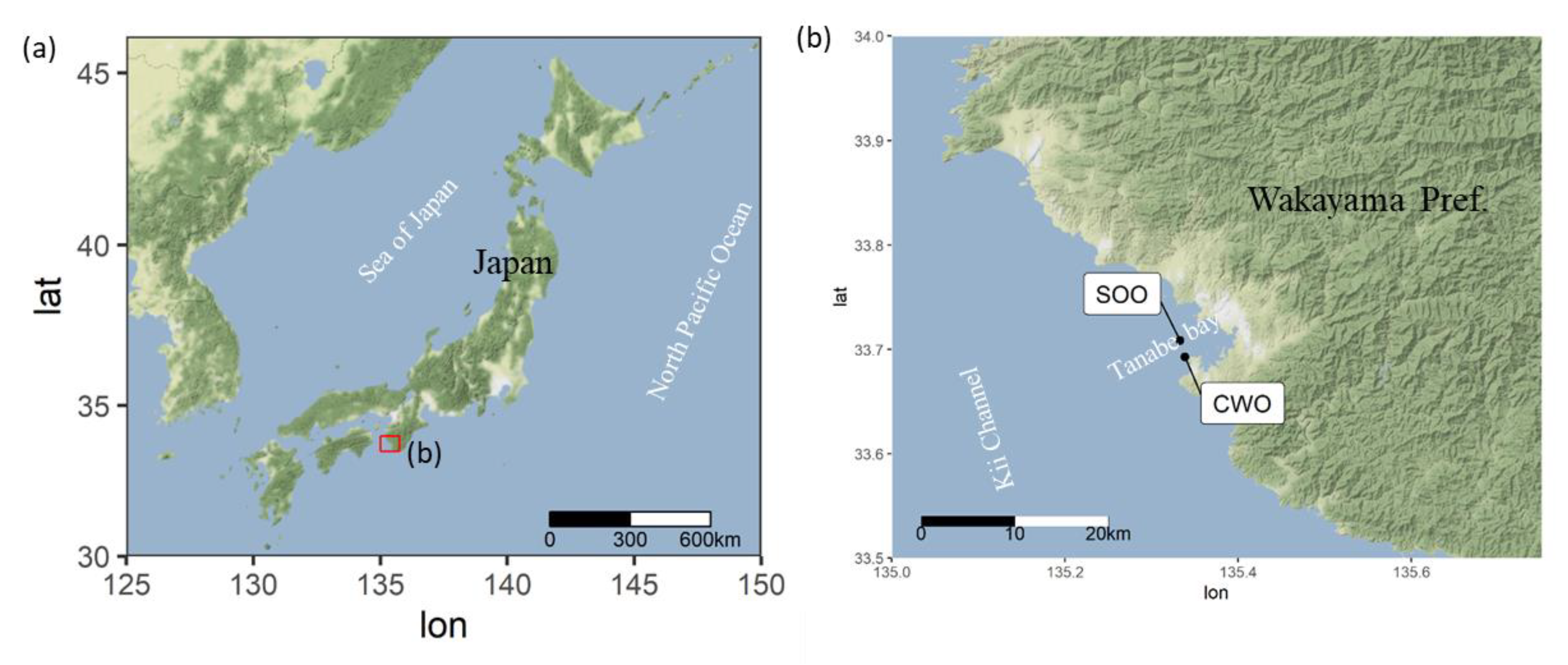
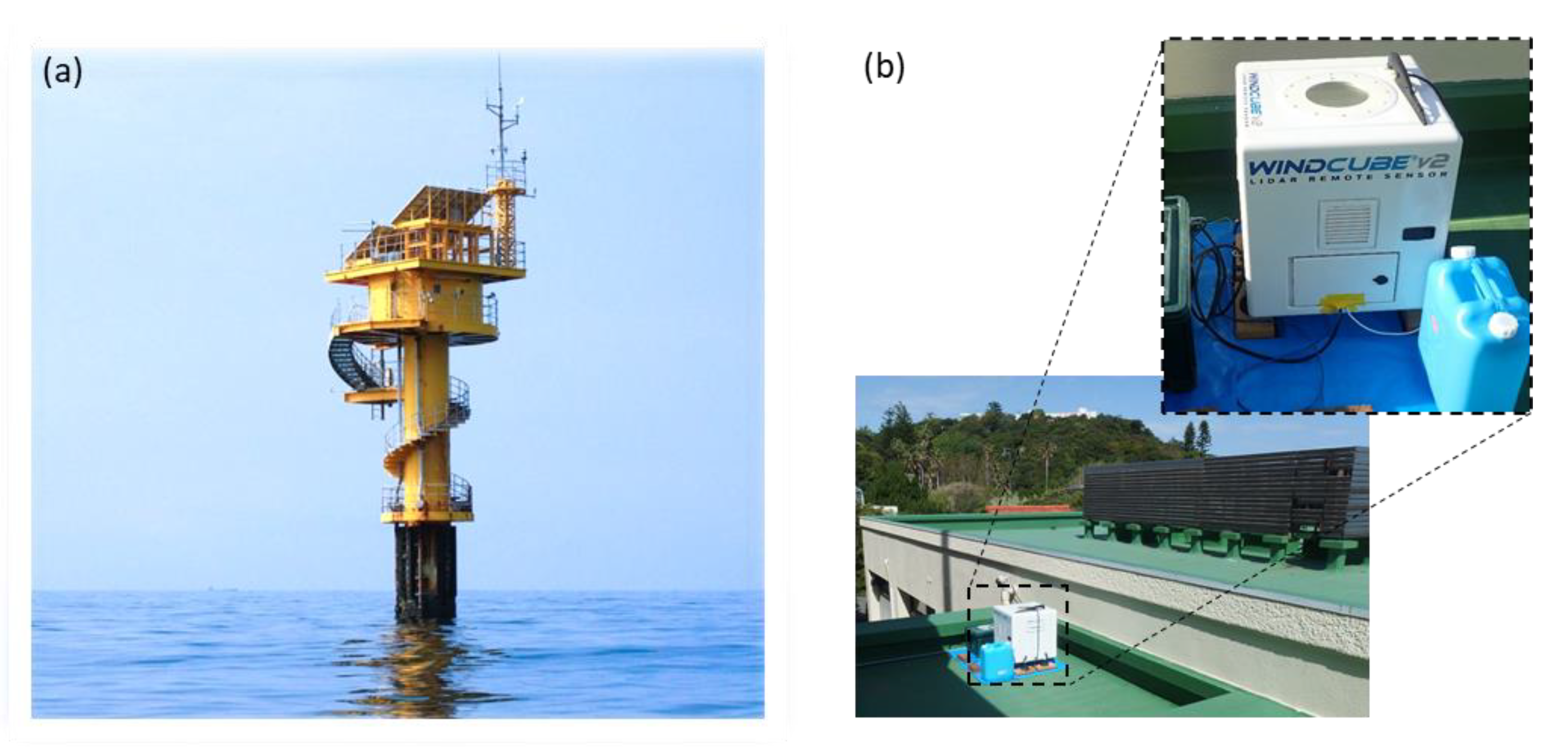
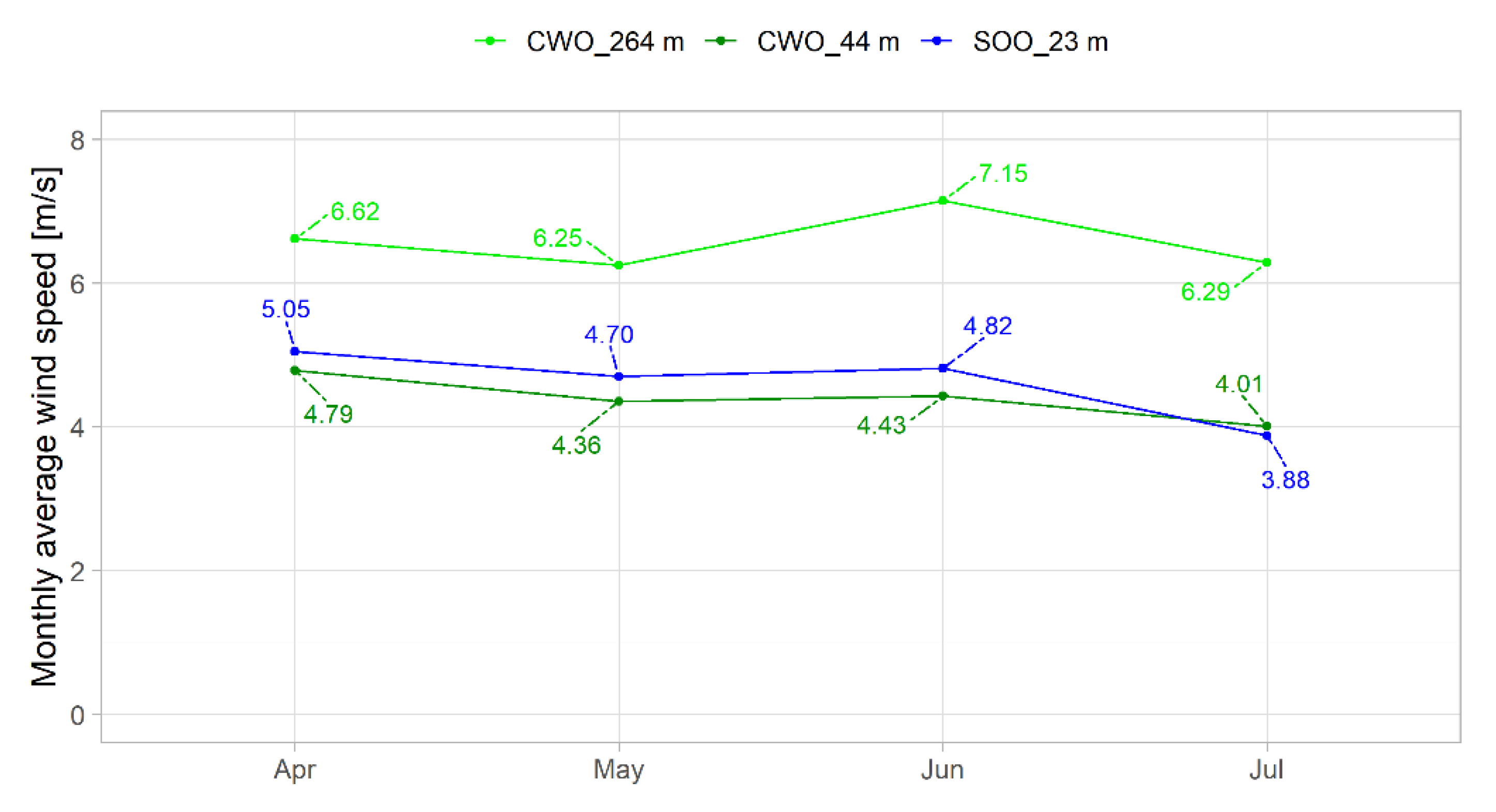
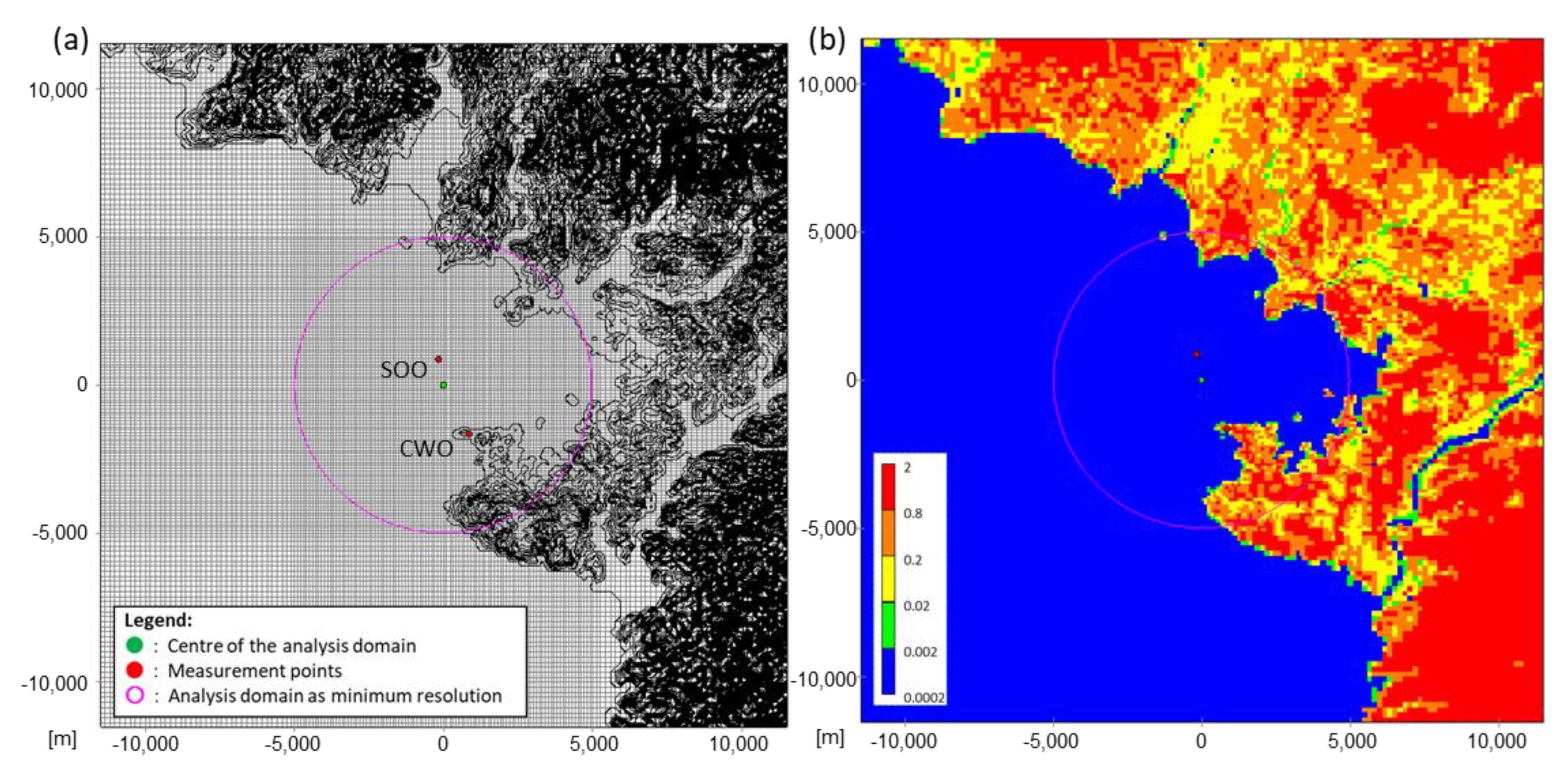
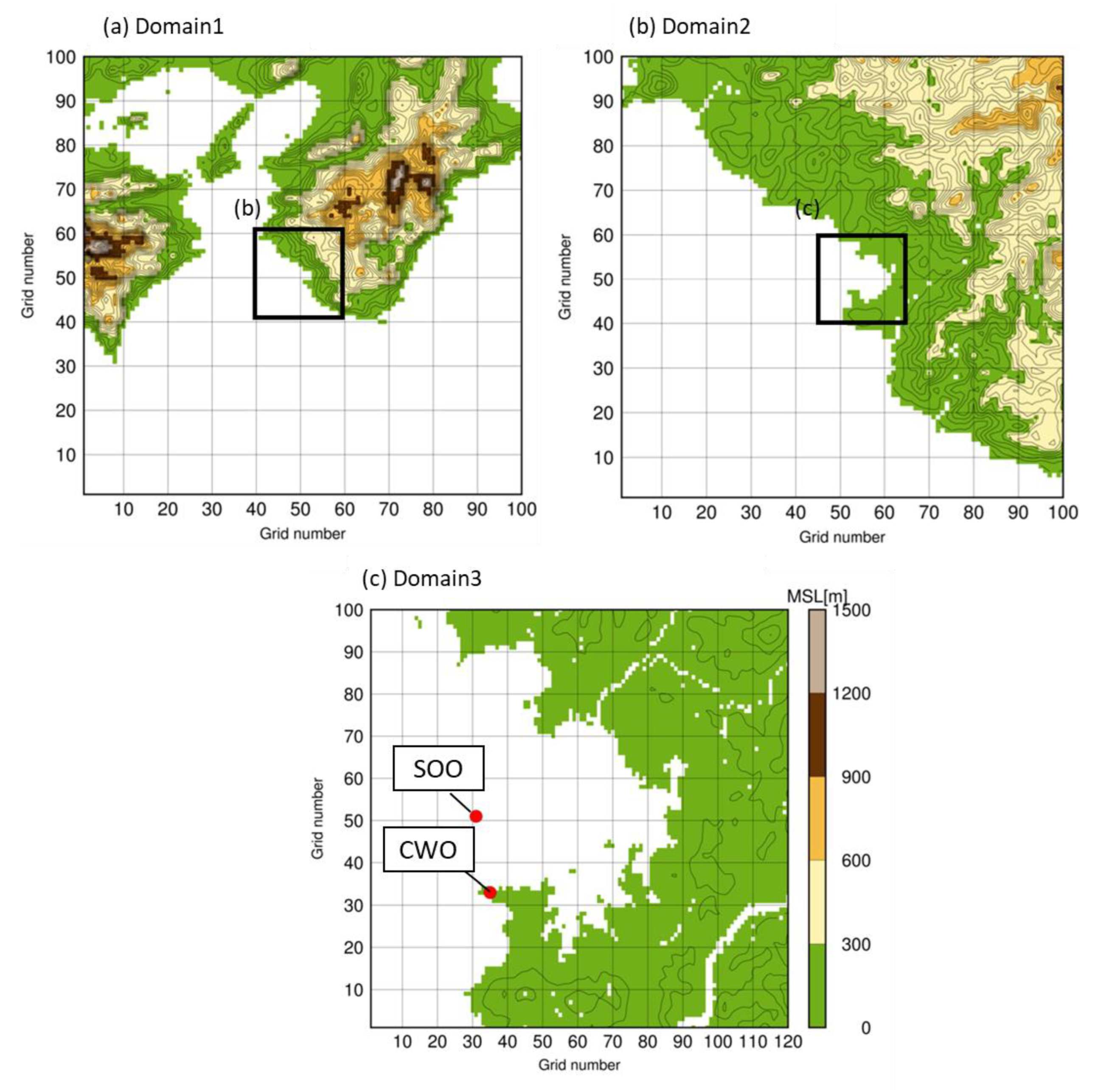

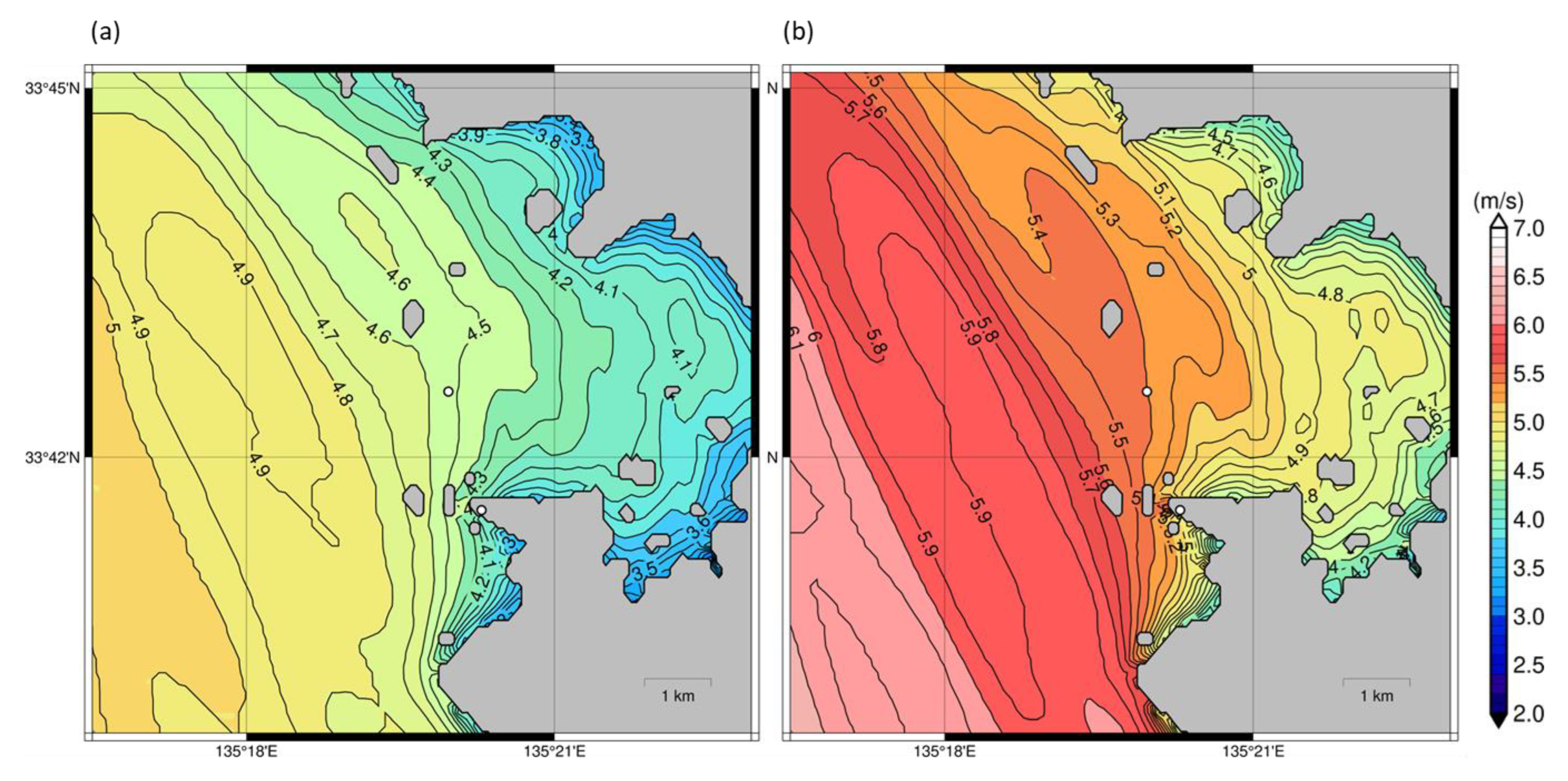
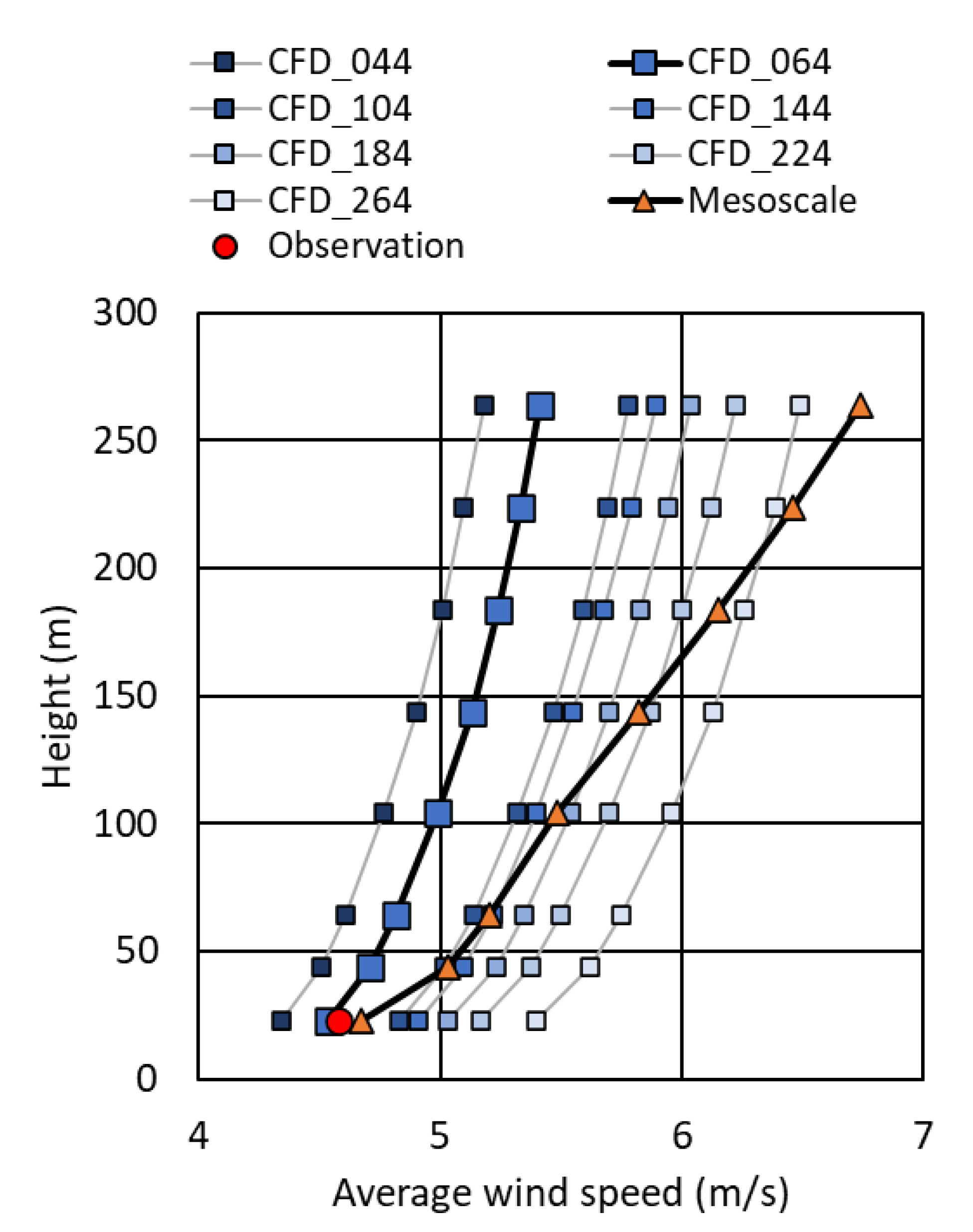

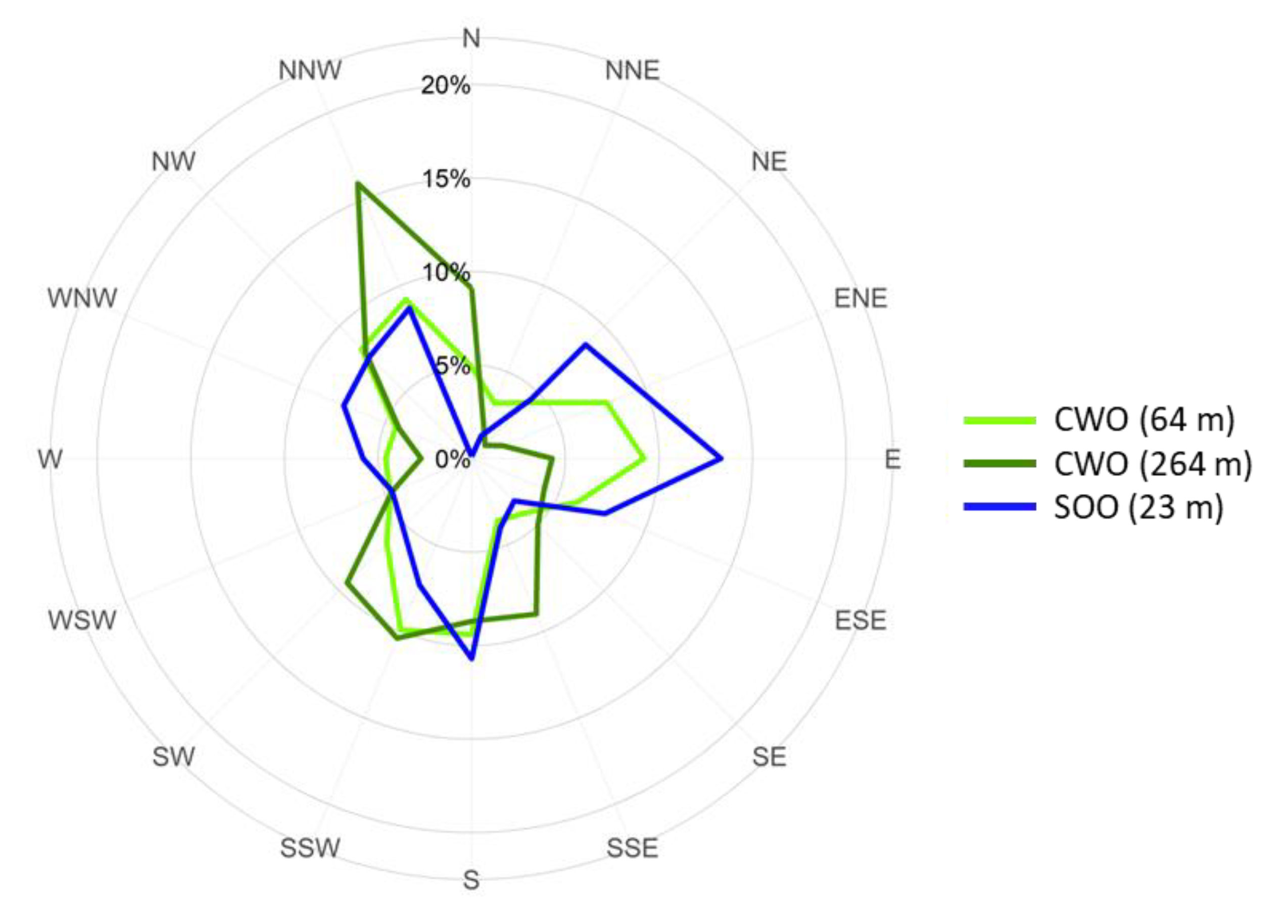
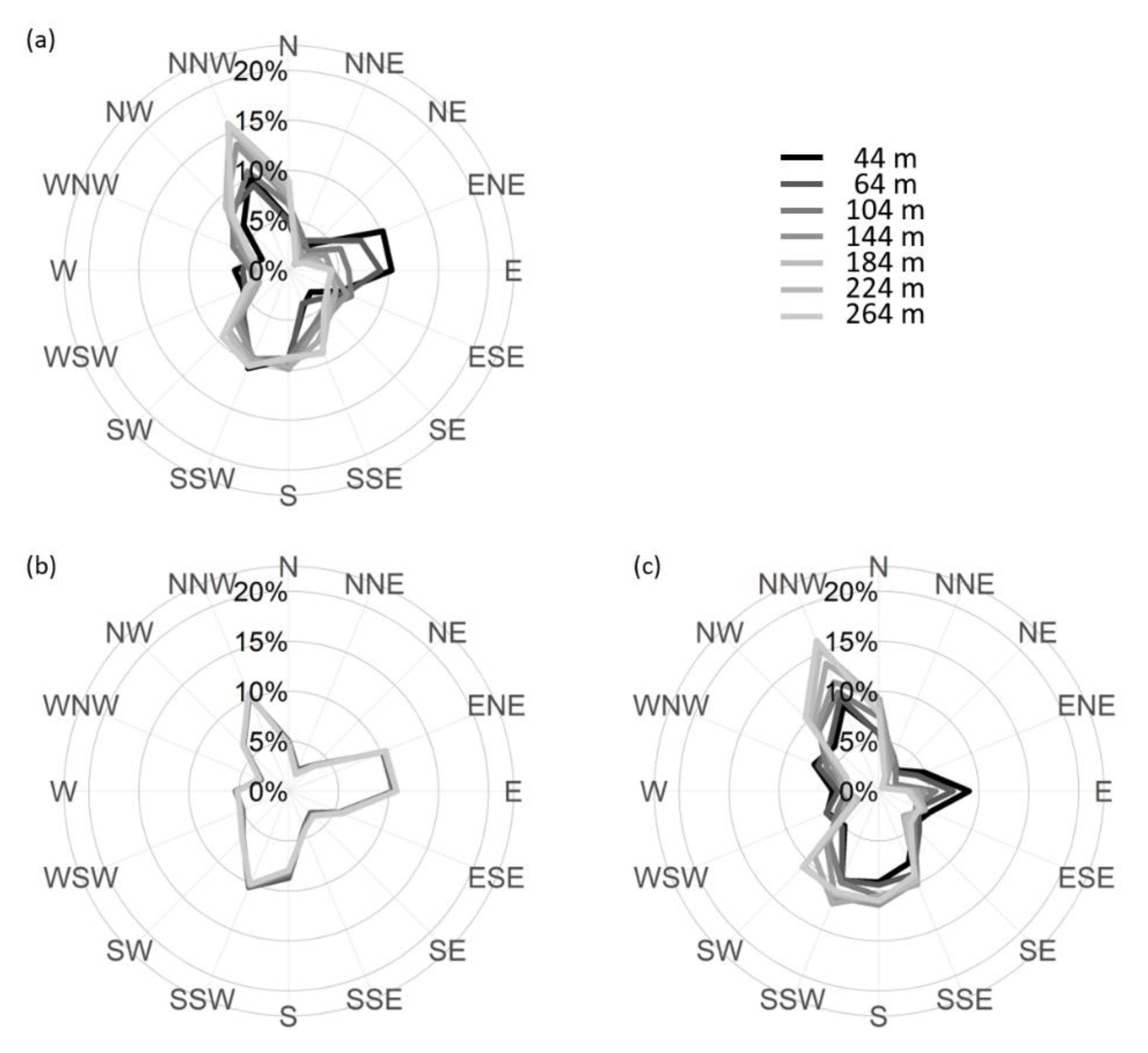
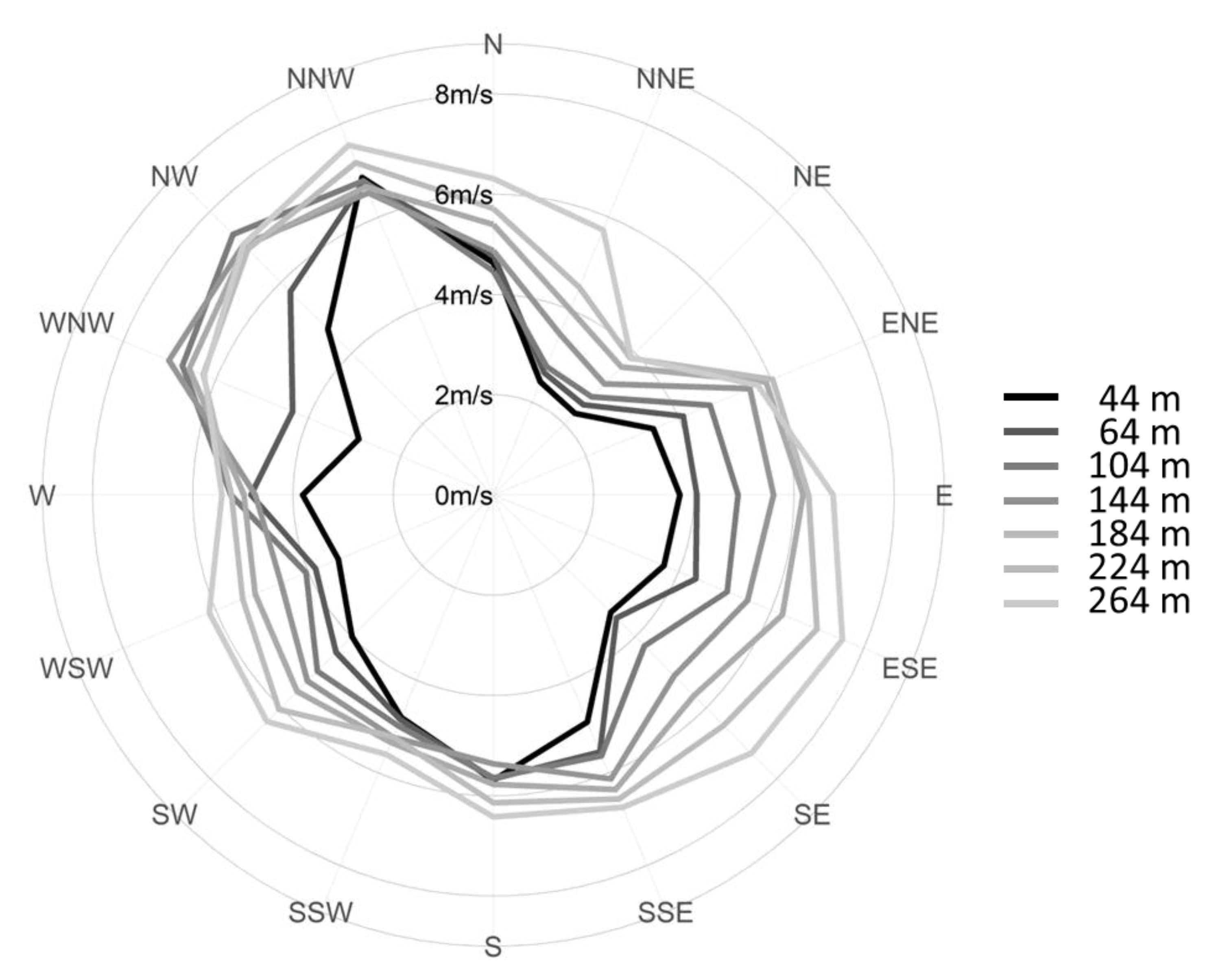
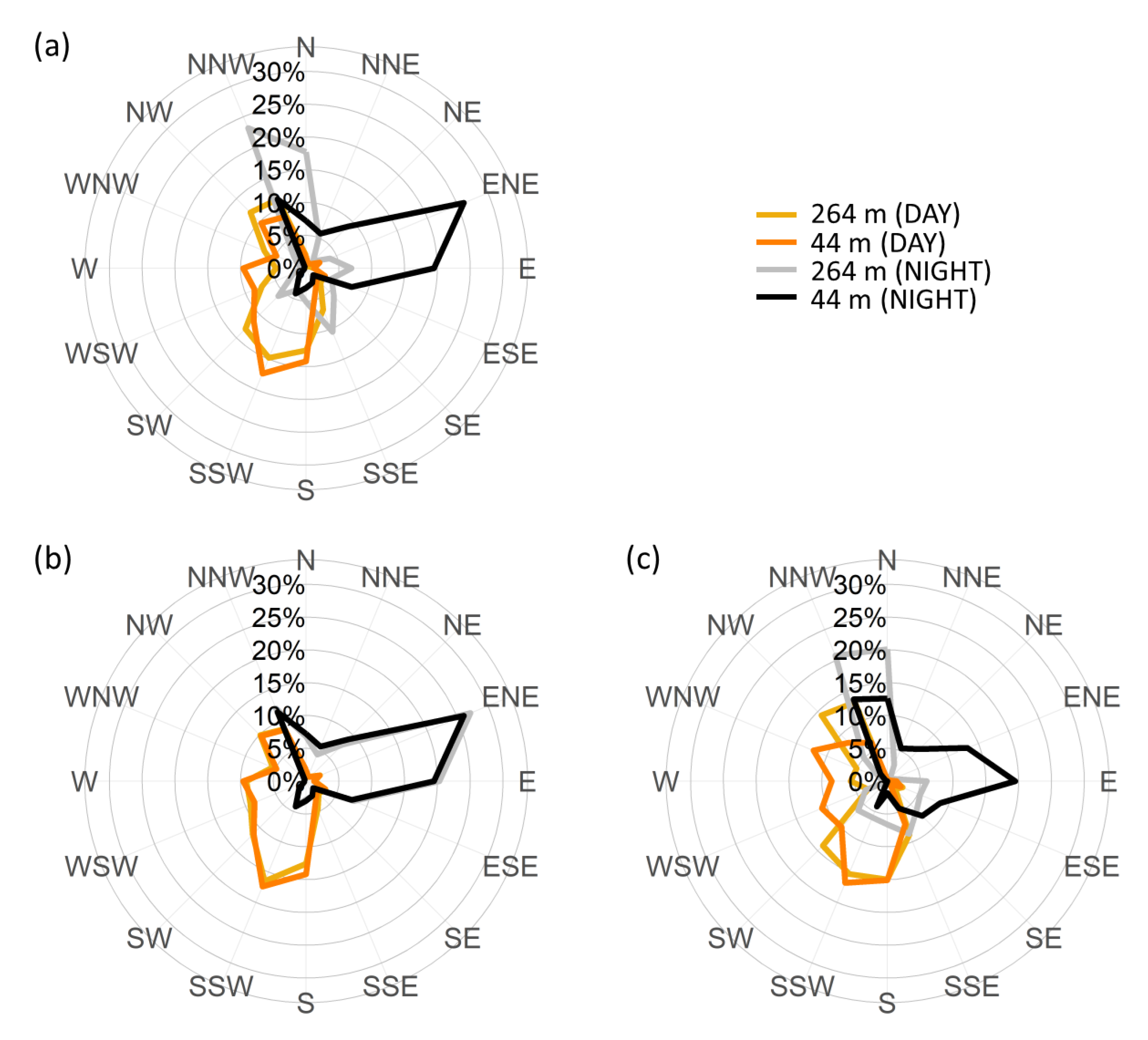


| LiDAR Model | Wind Cube V2 |
|---|---|
| Implementer | LEOSPHERE (Vaisala) |
| Number of observation heights | 12 |
| Observation height * | 40, 60, 80, 100, 120, 140, 160, 180, 200, 220, 240, and 260 m |
| Measuring range | Speed: 0–55 m/s |
| Direction: 0–360° | |
| Measuring accuracy | Speed: 0.1 m/s |
| Direction: 2° | |
| Averaging time | 10 min |
| CFD Model | Mesoscale Model | |
|---|---|---|
| Model | MASCOT | WRF |
| General description | A CFD-based non-linear model developed by Tokyo University, implementing the k-ε model, for the prediction of local wind in complex terrain in Japan. | A mesoscale model developed by the National Center for Atmospheric Research, and others, for atmospheric research and operational forecasting applications. |
| Wind field calculation | Steady calculation of wind fields for each of the 16 wind directions. | Continuous calculation of wind fields generated by time-varying boundary conditions. |
| Wind conditions at the target site | Wind conditions at a target site were calculated based on the measured wind conditions at a reference site and simulated wind fields. | Time series of the wind speed and direction at the grid point corresponding to the target site was extracted. |
| Boundary conditions (upstream) | Steady flow upstream in a virtual region, where the topography is flat and roughness is constant. | Global or regional analysis (re-analysis). |
| Model | MASCOT 3.2.4 |
|---|---|
| Center of the calculation domain | N33°42′28.213″, E135°19′44.400″ (Tokyo Datum) |
| Elevation data | 50 m grid DEM data * |
| Ground roughness | Based on the 100 m mesh land use data * |
| Size of the calculation domain | 23 km × 23 km |
| Wind direction | 16 directions |
| Minimum horizontal resolution | 100 m |
| Minimum vertical resolution | 5 m |
| Calculation domain as minimum resolution | Within a 5000 m radius |
| Number of mesh | 5,160,672 |
| Type | Roughness Length (m) |
|---|---|
| Rice field (Tanbo) | 0.03 |
| Field | 0.1 |
| Orchard | 0.2 |
| Other wood field | 0.1 |
| Forests | 0.8 |
| Wasteland | 0.03 |
| High buildings | 1 |
| Low buildings | 0.4 |
| Transportation area | 0.1 |
| Other area | 0.03 |
| Lakes and ponds | 0.0002 |
| River A: Does not include artificial land use in river areas | 0.001 |
| River B: Artificial land use in riverbeds | 0.001 |
| Beach | 0.03 |
| Sea | 0.0002 |
| Model | WRF (Advanced Research WRF) ver. 3.8.1 |
|---|---|
| Grids | Domain 1: 2.5 km × 2.5 km, 100 × 100 grids |
| Domain 2: 0.5 km × 0.5 km, 100 × 100 grids | |
| Domain 3: 0.1 km × 0.1 km, 120 × 100 grids | |
| Levels | 40 levels (Surface to 100 hPa) |
| Input data | 3-hourly, 0.05° × 0.05° JMA-MSM (for meteorological elements) |
| Daily, 0.02° × 0.02° IHSST (for sea surface temperature) [41] | |
| 6-hourly, 1° × 1° NCEP FNL (for soil) | |
| 4DDA | Domain 1: Enabled |
| Domain 2: Enabled, but excluding below PBL height | |
| Domain 3: Enabled, but excluding below PBL height | |
| Physics option | Dudhia shortwave scheme |
| RRTM longwave scheme | |
| Ferrier (new Eta) microphysics scheme | |
| Kain-Fritsch (new Eta) cumulus parameterization scheme | |
| Mellor-Yamada-Janjic (Eta) TKE PBL scheme | |
| Monin-Obukhov (Janjic Eta) surface-layer scheme | |
| Noah land surface scheme |
Publisher’s Note: MDPI stays neutral with regard to jurisdictional claims in published maps and institutional affiliations. |
© 2022 by the authors. Licensee MDPI, Basel, Switzerland. This article is an open access article distributed under the terms and conditions of the Creative Commons Attribution (CC BY) license (https://creativecommons.org/licenses/by/4.0/).
Share and Cite
Konagaya, M.; Ohsawa, T.; Mito, T.; Misaki, T.; Maruo, T.; Baba, Y. Estimation of Nearshore Wind Conditions Using Onshore Observation Data with Computational Fluid Dynamic and Mesoscale Models. Resources 2022, 11, 100. https://doi.org/10.3390/resources11110100
Konagaya M, Ohsawa T, Mito T, Misaki T, Maruo T, Baba Y. Estimation of Nearshore Wind Conditions Using Onshore Observation Data with Computational Fluid Dynamic and Mesoscale Models. Resources. 2022; 11(11):100. https://doi.org/10.3390/resources11110100
Chicago/Turabian StyleKonagaya, Mizuki, Teruo Ohsawa, Toshinari Mito, Takeshi Misaki, Taro Maruo, and Yasuyuki Baba. 2022. "Estimation of Nearshore Wind Conditions Using Onshore Observation Data with Computational Fluid Dynamic and Mesoscale Models" Resources 11, no. 11: 100. https://doi.org/10.3390/resources11110100
APA StyleKonagaya, M., Ohsawa, T., Mito, T., Misaki, T., Maruo, T., & Baba, Y. (2022). Estimation of Nearshore Wind Conditions Using Onshore Observation Data with Computational Fluid Dynamic and Mesoscale Models. Resources, 11(11), 100. https://doi.org/10.3390/resources11110100






